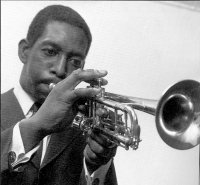|
Neither a dizzy technician nor a miles minimalist, Dorham occupies a middle ground with his pleasant, personalized trumpet tone. Whistle Stop Jan. 1961 / Blue Note RVG Dorham is a considerate artist, mostly cliche free even in mainstream efforts like this. He doesn’t write cookie-cut tunes just to have something to play, nor does he rip off a lot of acrobatic trumpet lines to live up to the instrument’s bravura reputation. He depends on warmth and richness, at least from what I’ve heard. This semi-classic hardbop date paints a well-rounded picture of Dorham, backed by Hank Mobley, Kenny Drew, Paul Chambers, and Philly Joe Jones. Straightahead fans will enjoy the first two cuts: “Philly Twist” sounds like “Billie’s Bounce” and a couple of other popular blues heads melded together, and “Buffalo” fits the Jazz Messenger mold. Then the music deepens with “Sunset”, a moody piece that swings in a beautifully unhurried way, with Dorham muted. The “Sunset” theme’s cadence illustrates a compositional hallmark of Dorham’s, where the rhythm goes into stop time under different chords and long melody notes. Don’t know if I’m explaining it well, but you can hear this in some of his other tunes, like “Brown’s Town” from Joe Henderson’s In ‘n Out. The title track alters some standard chord changes and gets whapped into shape by Philly Joe. Latin rhythms and melodic incantations make “Sunrise In Mexico” a memorable track, thanks especially to Mr. PC’s bass parts and the stealthy drums. “Windmill” provides an outgoing climax, then “Dorham’s Epitaph” ends the program on a few suggestive notes.
Overall, this is a very decent disc, worth acquiring for “Sunset”, “Sunrise”, and “Windmill”. I used to own a limited edition that came out in the 1990s, and now there’s a stronger sounding RVG.
Not as experimental as you might think, looking at the supporting cast of Joe Henderson, Herbie Hancock, Butch Warren, and Tony Williams. They do good work, of course, but Dorham’s three solid originals don’t present many challenges. “Straight Ahead” is just that – a basic template for blowing. The boogie blues “Una Mas” runs for a quarter hour; a lot of that time is taken up by entertaining solos, but the reprise at the end (“Una mas!”) is totally unnecessary, as the groove has long since been used up. “Sao Paulo” is a more sublime venture into Latin jazz, and it’s the real star of the album. (A Joe Henderson BN boxset from the 1990s kicked off with this track.)
In most respects, this is a middle of the road date, and recommended to fans of such. The bonus track “If I Would Ever Leave You” doesn’t broaden the field, either. Patrons of Kenny and/or Joe will hear a lot of good playing, though. This was Henderson’s Blue Note debut, and one can already pick him out blindfolded. His tenor sax finely complements Dorham’s pearly trumpet, and they would become quite the pair on albums to come.
Dorham teams with Joe Henderson, Tommy Flanagan, Richard Davis, and Tootie Heath on this first-class album. The twelve-minute title track impressively explores a Spanish mood, with a great solo from Henderson (including some exciting overblowing), probing work from Dorham, and a lighter rhythmic foundation for piano and bass solos. The remaining three tracks are just as good. “Night Watch” renders hard-bop ideas in a casual way, while the vulpine corners of “The Fox” are more outwardly complex. The obligatory Blue Note boogie number arrives in Henderson’s “Mamacita”, although the melody, bassline, and solos are far from dull.
Dorham’s overall feel on the trumpet tends to stand out more than individual phrases, though he has some good ones. Meanwhile, this is as fine a record as Joe Henderson cut in the ‘60s, and that’s saying something. From the “Trompeta Toccata” solo onward, he’s in the zone. Flanagan has a couple of bright moments, and Richard Davis does a typically smart job on bass. Recommended. |
